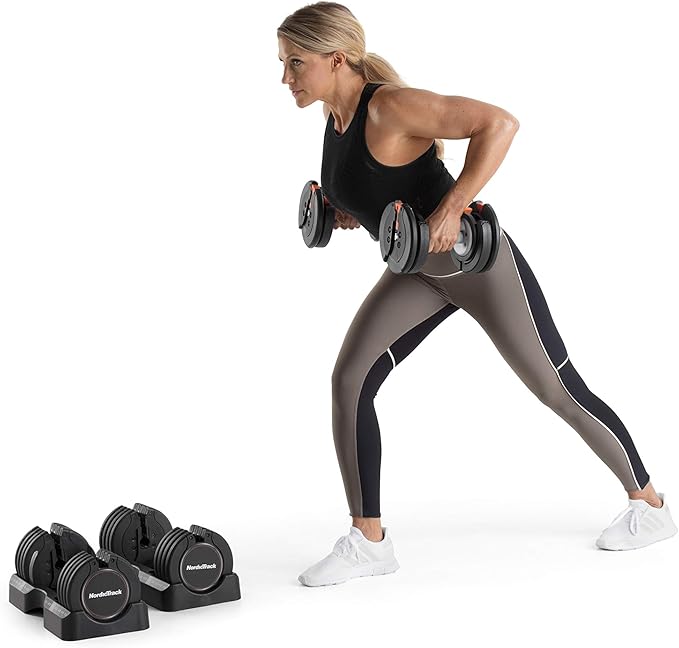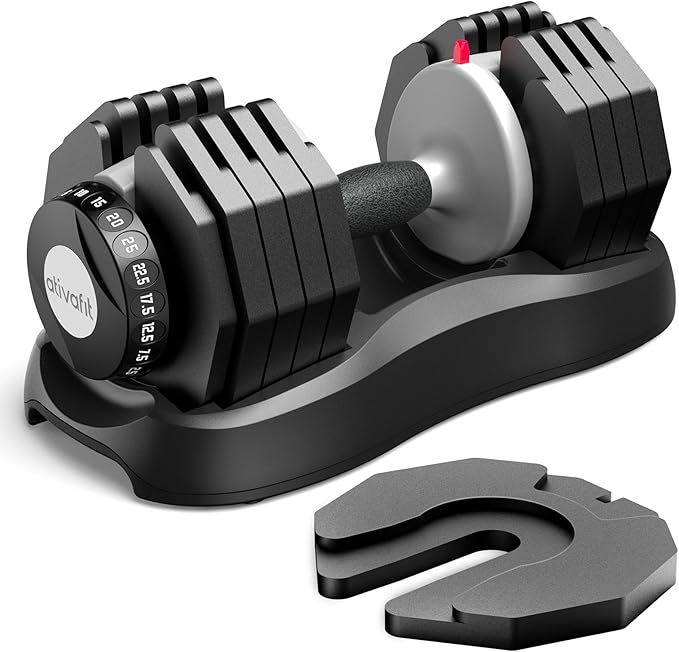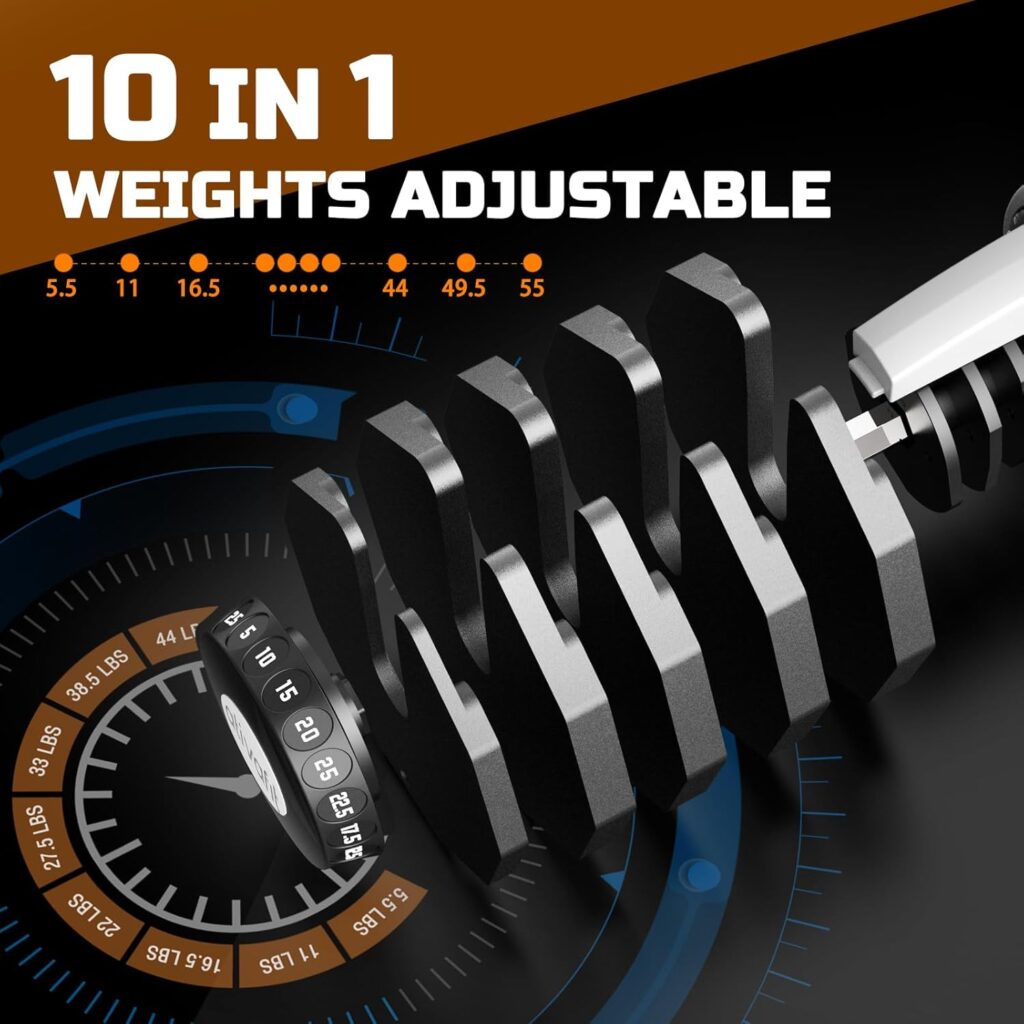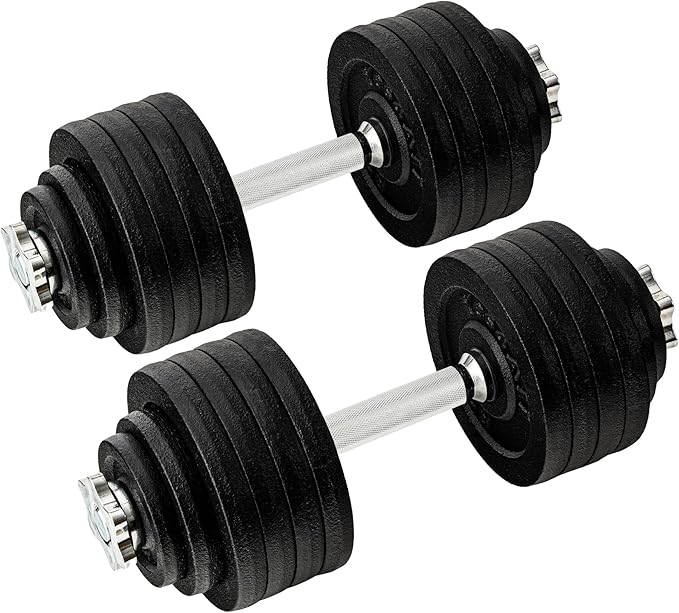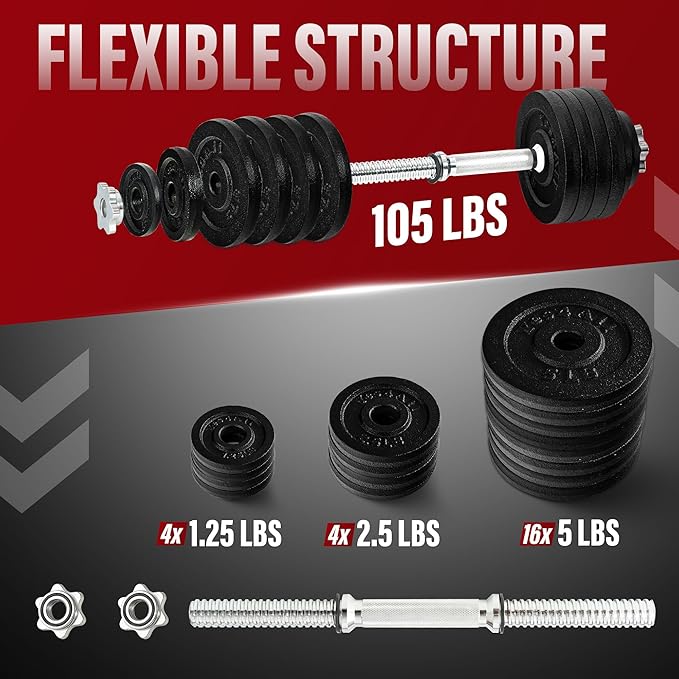Introduction
The older we get, the more essential it becomes to be strong and healthy muscle mass-wise. But not always does it do to have simply the perfect exercise equipment for your apartment.
Adjustable dumbbells come in handy.
Those clever devices revolutionized home gym workouts, particularly with the elderly population that is confronted with insufficient space to work out at home.
When I initially began monitoring my fitness in my golden years, I quickly discovered that fixed dumbbells were occupying too much space in my compact apartment. Discovering the adjustable dumbbells was the best thing that could have occurred to me, and I’m glad to inform you why they are the best for seniors who desire to stay healthy and strong.
Why Adjustable Dumbbells are Ideal for Seniors
Space-Saving Design
The greatest thing about adjustable dumbbells is how compact they are in terms of occupying space. In comparison to a single fixed set of dumbbells that could occupy the space of an entire rack or corner shelf in a room, adjustable dumbbells will usually take up the space one set would.
That in itself makes them perfect for apartment residents, or even for the rest of us whose houses have anything but spacious real estate to devote to exercising equipment.
You simply store them in a closet, under a bed, or in the corner and your living area will be maintained in order, with a peaceful home life to boot.
Versatility
You can get through an entire series of exercises for a whole group of muscles with a single set of adjustable dumbbells. We are not trying to improve maximal strength and bone density, and that’s why.
You will be able to start off with light dumbbells when performing shoulder lifts or bicep curls and simply switch to heavy dumbbells when performing squats or chest presses.
This ease of quick switching between dumbbells enables one to get a better exercise without having to work with numerous sets of dumbbells.
Cost-Effective Solution
Buying a set of adjustable dumbbells is cost-effective in the long run compared to purchasing several sets of fixed weights dumbbells. Instead of purchasing multiple person pairs for accommodating a variety of weights, they are in one compact package.
This approach is more gentle on our pension money and does not require the need for a large, expensive rack to hold several dumbbells.
Easy to Use
Adjustable dumbbells are typically made for seniors by most companies, with easy-to-grip handles and simple mechanisms for weight adjustment. This feature particularly proves useful for us with arthritis or reduced hand strength.
Easy and quick weight fluctuation is easier on our hands and wrists, and we don’t need to focus on readjusting equipment as much.
Progressive Overload
If we’re developing strength, dumbbells with adjustments allow us to utilize progressive overload by incrementally adding the weight we are lifting. Progressive overload theory is significant for the continuation of developing strength and for maintenance of the muscles.
For fixed-weight dumbbells, you may end up having to buy new sets as you advance.
Adjustable dumbbells, however, expand with you and provide multiple weight adjustment in one purchase.
Best Adjustable Dumbbells for Seniors on Amazon Now that we’ve discussed some of the reasons why adjustable dumbbells are especially suited for seniors, let’s have a look at some of the top rated ones on Amazon. I’ve personally used or reviewed each of these models separately on ease of use, weight capacity, and overall value.
1. Bowflex SelectTech 552 Adjustable Dumbbells
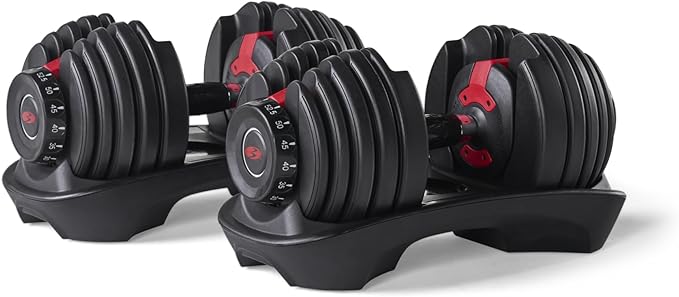
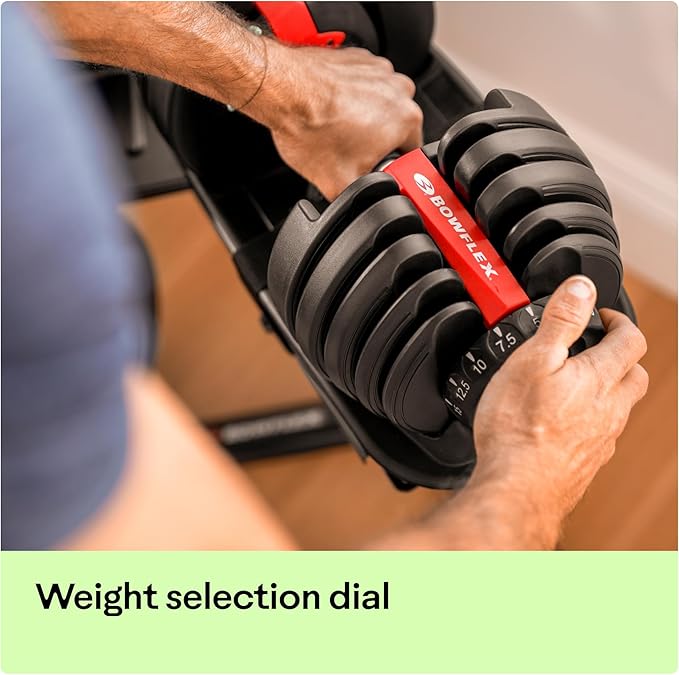
The Bowflex SelectTech 552 is a favorite among the seniors and for very good reasons. The dumbbells go from 5 pounds to 52.5 pounds and give you an amazing range of weights that would be perfect for any type of workout as well as for any level of strength.
The reason why these are so great is that they have a very easy-to-use dial system. When you want to change the weight, you simply turn the dial to where you require it.
This is a wonderful feature for people who have arthritis or a poor hand grip because it is not difficult to change.
The ergonomic shape of the handle enables it to be held tightly, and this is essential in order not to risk having accidents while exercising. The ridges on the surface provide yet another level of safety even if your palms are sweaty while exercising.
The only possible drawback of these dumbbells is that they are just a bit too big, even when filled with lighter weights. But the majority of seniors find their convenience and great range of weight well worth sacrificing some compactness.
2. PowerBlock Elite Dumbbells
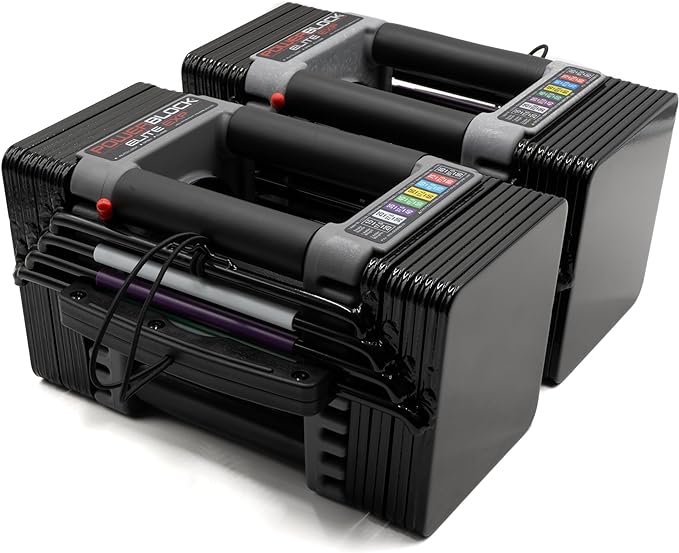
PowerBlock dumbbells are unique in being designed particularly in a corner. The lack of a roll provides safety, making this particularly for seniors with such a problem.
If you dropped or misplaced a PowerBlock dumbbell by accident, it remains in place rather than wandering off somewhere or hitting your toe.
They are extremely compact in size, hence ideal to be installed under restrictive conditions. They utilize a selector pin setting system conveniently regulated, much like weight gear used in the fitness club.
This is simple to use, but will require a bit more manual dexterity than the Bowflex dial.
The range of weight is typically 5 to 50 pounds per hand, and this will give you plenty of range to have the ability to still add your strength training. The incremental step between weights is less than almost any other adjustable dumbbell available, so you’ll be able to make smaller incremental gains as you build up.
3. NordicTrack Select-A-Weight Dumbbell Set
NordicTrack Select-a-Weight Dumbbell Set offering in the adjustable dumbbells segment is highly popular for its soft handle, which is a necessity among senior citizens. The handles are specifically curved to fit the natural shape of the hand and have a lightly textured surface to prevent slippage.
This range will handle a weight range of 10 to 55 pounds, suitable for most senior exercise programs. The adjustment mechanism is a turn and slide handle along with a slide pin, both simple and easy to use for some individuals.
One feature of this set that stands out is the storage tray included with it. The tray organizes your workout area and keeps everything safe, reducing the potential for tripping over loose weights.
It also facilitates adjustment because the dumbbell is safely held in the tray while adjusting.
4. ATIVAFIT Adjustable Dumbbell – Single
For seniors looking for a lighter option, the ATIVAFIT adjustable dumbbell is an excellent choice. It generally varies from 5.5 to 27.5 pounds, ideal for beginners or those looking to perform light weights during workouts.
The small size of the ATIVAFIT dumbbell is ideal for compact rooms. You can simply store this under the bed or in a compact closet when not in use.
Its adjustment system is likewise easy to use, with a push-pull selector that feels soft on hands.
One downfall is that it is sold as a single dumbbell rather than a set. But for many seniors, using one dumbbell at a time can be easier, especially when starting out or with balance issues.
5. Yes4All Adjustable Dumbbell set
These Yes4All Adjustable Dumbbell set are more classic in nature, employing weight plates and spin-lock collars. Though they are slightly more of a hassle to change weight than others, they are cozy in a familiarity that will suit some seniors.
Yes4All dumbbells are very cheap and therefore the perfect choice for budget-conscious seniors. They have step-weight increments, which is beneficial for novice strength trainees.
An advantage is that you have better precision over the weight than on other models. You don’t have to contend with pre-set increments, but you can just add or remove small plates to get precisely the weight you need.
The worst thing is the time spent on switching weights. If you’re working on a routine that will involve repeated switching of weights, then this would be problematic.
But if you’re working on straightforward routines or you prefer the workout of manually switching, these are a good fit.
How to Choose the Best Adjustable Dumbbells for Your Senior Fitness Routine
The choice of the best set of adjustable dumbbells is influenced by numerous factors. The following are things to keep an eye out for as you make your choice:
Weight Range
Choose a range from which you can create a set. You should start light, especially if you are new to strength training or are returning after an extended break.
But you also have to consider there is room for adding weight as you gain strength.
For most older adults, a set which starts at 5 pounds and goes up to at least 25-30 pounds will do. If you just so happen to be quite strong to begin with or have specific goals which necessitate heavier, then utilize sets up to 50 pounds or higher.
Remember that it is preferable to have one a little above your current level than to outgrow dumbbells too quickly and have to buy a new set.
Adjustment Mechanism
Simple weight adjustment is handy, especially for older people with possible hand strength or dexterity problems. Buy dumbbells with simple adjustment mechanisms.
Dial or selector pin mechanisms are easier for older people to manage than spin-lock collars.
If possible, visit the adjustment mechanism prior to purchase. Sporting goods stores will more than likely carry demo models for you to try out.
Test the pressure you must apply to change the weight and determine if it feels good to you.
Grip Comfort
Handle comfort is more important than you know. You will be gripping these dumbbells again and again, so make sure that the handles are comfortable and secure in your hand.
This is especially essential if you suffer from arthritis or reduced hand power.
Opt for dumbbells whose handles have an ergonomic design. Some of them also come with rubberized or contoured grips that can provide extra comfort and safety while exercising.
The handle diameter is important as well – it should be a good fit in your hand, not too fat or too skinny.
Stability
Use well-balanced, stable dumbbells when lifting. This reduces the possibility of accidents. The dumbbell must be steady when lifted and not rock or shift.
A few styles, such as flat bottom PowerBlock dumbbells or square dumbbells, provide extra stability on the ground. This will be helpful to older users who worry that dumbbells may roll out of their reach.
Size and Storage
Consider how much space you have available to put your dumbbells away. Adjustable dumbbells may include storage trays, which can be beneficial for safety and convenience.
These trays are typically also the surface that you adjust the weights on.
Measure out your planned storage space prior to buying to ensure a proper fit. Keep in mind, though adjustable dumbbells take up less space than a full set of standard dumbbells, some are fairly large, particularly at heavier weights.
Build Quality and Durability
Spend money on a set of dumbbells that will be durable. Find models constructed of good materials that will withstand frequent use.
Read reviews by customers to find out how long-lasting the dumbbells are in the long term.
Observe how long the adjustment mechanism will last, as this will usually be the weakest point. A well-made set of adjustable dumbbells should last you for years of exercise.
Price and Warranty
While it is a desire to pay the cheapest price, remember that it is an investment into your own body and health. While a good adjustable dumbbell set is pricier at the beginning, it will be a good investment in the long run rather than buying multiple sets of single single-weight dumbbells.
Look for the manufacturer’s warranty. The longer the warranty, the more confident they will feel about how long it will last.
There are wonderful brands that will provide excellent customer service and even replace units or parts if there is an issue.
Adding Adjustable Dumbbells to Your Senior Fitness Program
After you’ve chosen your adjustable dumbbells, it’s time to get active with them. Here’s some tips on how to use them in your senior exercise routine:
Start Light and Focus on Form
Start light so you can focus on form and not hurt yourself. Better to start too light than too heavy.
This will make you used to your technique and feel prepared before adding weight.
For all exercises, start with weight for which you can perform 12-15 reps in correct form. If it is too light to be able to perform more than 15 reps, then add weight.
Utilize Gradual Progression
Slowly increase the weight over a period of time. Small increments can make a big difference in increasing strength.
If you are able to achieve 12-15 repetitions of proper form with ease for two or three consecutive workouts, increase the weight by 5-10%.
Don’t panic if you have to stay at the same weight for a few weeks. It is about consistency, and your body will get used to it and get stronger if you exercise regularly.
Develop a Full-Body Workout
Use your dumbbells to do a mix of exercises that work different muscle groups. This provides overall strength and mobility.
Exercises to employ:
1. Bicep curls for arm strength
2. Shoulder presses for upper body strength
3. Dumbbell squats for lower body strength
4. Dumbbell lunges for leg strength and balance
5. Bent-over dumbbell rows for back strength
6. Chest presses (can be performed lying on a bench or floor) to develop chest strength
7. Tricep extensions to develop arm strength
Attempt to include exercises for all of the major muscle groups in your training regimen. This balanced regimen avoids muscle imbalances and encourages overall functional fitness.
Balance and Stability Exercises
The more critical your balance becomes as you age. Challenge your balance and enhance your stability with your adjustable dumbbells.
Following are some of the tips:
1. Single-leg deadlift: Stand on one leg with one dumbbell in hand.
2. Shoulder stand press: One-leg shoulder press.
3. Farmer’s walks: Dumbbell walks with good posture and head up.
Have a stable support or surface to work from at any time that you are performing balance exercises. Safety is the number one concern at all times.
Provide Adequate Rest and Recovery
Do not cut corners and rest after strength training. We heal more slowly as seniors, so pay attention to your body.
If at all possible, rest for a day after strength training. If you really do feel sore and tired, do take an extra day off.
That’s where your muscles heal and get stronger, so it’s a vital part of your exercise regimen.
Use With Cardio Exercise
Adjustable dumbbell strength training is needed, but don’t overlook cardio. Strength training and cardio must be part of any exercise regime for older adults.
You may swap your dumbbells’ strength training days with your cardio days such as walking, swimming, or biking. This will yield total fitness and wellness.
Safety Tips for Seniors Using Adjustable Dumbbells
Safety is the farthest from our thoughts while working out and even further with increasing age. A few safety tips to keep in mind are as follows:
Consult Your Doctor
Always consult your doctor first before embarking on a new exercise program to make sure that it is safe for you to perform. This is especially important if you have any illness or injury.
Your doctor can provide you with customized advice based on your condition and might even have some suggestions on exercises that would be best for you.
Learn and Use Proper Form
Good form will allow you to get the most benefit from every exercise and reduce the risk of injury. It may be worth the expense of paying for the services of an advanced-level specialist personal trainer for at least some of the first few sessions to advise you.
A trainer will also demonstrate proper form to perform each exercise and provide modifications, if needed. They can even design a custom workout routine based on your needs and goals.
If a trainer is not an option, there are all kinds of websites and YouTube videos designed specifically for senior exercise. Just do it slowly and listen to your body.
Always Allow time to Warm Up
Never skip your warm-up. Your warm-up makes your muscles and joints available to work, circulates the blood, and avoids injury.
Begin with 5-10 minutes of low-intensity cardiovascular training, such as marching in place or in-place walking. This can be followed by dynamic stretching, moving your joints through their range of motion.
These may include arm circles, twist slowly, and leg swings.
Cool Down and Stretch
Cool-down and stretch following exercise. This will normalize a heart rate and avoid sore muscles.
Stretch 15-30 seconds with one muscle, slow and deep breathing but don’t bounce.
Listen to Your Body
Listen to what your body says when exercising and even afterwards. Soreness with some related muscle fatigue is okay, but stinging pain is not acceptable.
If it hurts (and not just caused by muscle fatigue), you’ll have to stop.
Discriminate between normal exercise muscle soreness and soreness that is an alert signal for injury. In uncertainty, err on the safe side and cease.
Stay Hydrated
Drink water prior to exercising, when exercising, and after exercising. Your body will then be aided in heat control, delivery of nutrients, and level of exercise energy.
Use a Spotter When Necessary
For overhead lying or weight lying, a spotter would be ideal. Your family member, buddy, or workout partner can be your spotter.
Your spotter will save you from being stuck under a weight and prevent accidents from occurring.
Taking Care of Your Adjustable Dumbbells
In order to give your investment an extra value for the long run, the following tips on how to treat it so that you are able to maintain it in its best shape will come in handy:
Regular Cleaning
Wipe your dumbbells clean after use to avoid rust. Especially if you’re dripping with sweat. Soap or damp cloth, then dry rub.
Weekly Mechanism Check
Take a few minutes a week and check the adjustment mechanisms on your dumbbells. Make sure they turn freely and there is no wear or damage.
If not correct, have the manufacturer provide instructions or have them bring in for repair.
Proper Storage
Store your dumbbells in a dry place to avoid rusting if they contain metal parts. Don’t store them in humid places such as basements or garages.
Use the storage tray that comes with your dumbbells if available.
This will keep your weights tidy and can prevent your dumbbells and your floors from getting damaged.
Handle with Care
Don’t let dumbbells fall, as they will damage the adjustment mechanism and hurt you. Carefully place them on the floor or stand after exercise.
Treat carefully while adjusting weight and ensure the mechanism is tightly engaged before lifting.
Frequently Asked Questions
Are adjustable dumbbells ideal for beginners?
Dumbbells with adjustable weights are best suited for beginners, even the old at the onset. You start using very minimal weights and increment slowly as you build strength and bravado.
How much should a 70-year-old lift?
How much weight a 70-year-old can manage is mostly based on individual fitness, health, and motivation. Light weights are to be begun and progressively increasing weight added under the direction of a fitness professional or medical doctor.
Can older adults gain muscle?
Indeed, older individuals also build up muscle with strength training. Their muscle gain might not be the same as it would be among young adults, but consistent strength training can actually achieve significant gains in muscle gain and strength as well.
How often should elderly persons train using weights?
Most health associations recommend that the older adult conducts strength training on at least a two-day schedule per week. How frequently the week is to be determined relative to individual exercise and recovery needs.
Worthy of having around the house? Adjustable dumbbells.
Adjustable dumbbells are definitely worth the money for home workouts, especially for small space scenarios. They provide an amazing range of weight choice in an utterly tiny space footprint, and they’re ideal for home workouts.
What are some exercises seniors can do with dumbbells?
Seniors can perform any number of dumbbell exercises like bicep curls, shoulder presses, squats, lunges, chest presses, and rows. The point is to start with light weights and use correct form.
How long should a senior exercise?
The duration of exercise for a senior is not fixed, but the typical strength training exercise would be 20-30 minutes. The point is to be consistent and not the duration of the workout.
Can adjustable dumbbells substitute for a gym membership?
For the average older adult, a pair of adjustable dumbbells and body weight exercise and aerobic exercise will be as effective as a full workout, and could make a gym membership superfluous.
How are adjustable dumbbells different from fixed dumbbells?
Adjustable dumbbells let you select how much one dumbbell weighs, but fixed dumbbells are always a definite weight. Adjustable dumbbells are convenient but are less intuitive to some than fixed dumbbells and are not as room-consuming.
How do I know if I’m lifting too much?
If you’re unable to maintain good form on the exercise, feel severe stinging or burning, or are unable to perform as many repetitions as you want, then it’s too heavy. Good form is always preferable to heavy weight.
Key Takeaways
Adjustable dumbbells are a space-saver that are perfect for seniors looking to keep their strength and muscles. They are all different weights in one tight package, perfect for a space-saving home gym.
When choosing adjustable dumbbells, look for weight range, adjustability, grip comfort, and quality of the build. Start with light weights and correct form and gradually add weight as you get stronger.
Include a series of exercises involving more than one muscle at the same time into your training, balance training, and stability training. Always take precautions not to put yourself at risk by getting it approved by your doctor, warming up thoroughly, and paying attention to your body’s limits.
Worn and used every day, adjustable dumbbells can be a good supplement to your workout routine for seniors and keep you strong, limber, and independent well into your golden years.
Disclosure: This site contains affiliate links, and we may earn a commission at no extra cost to you.
